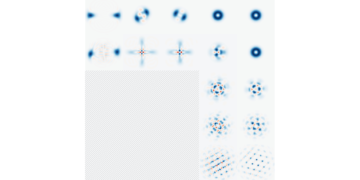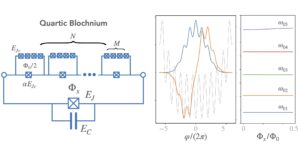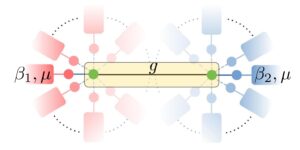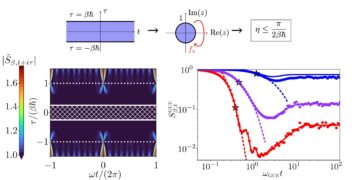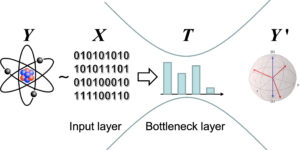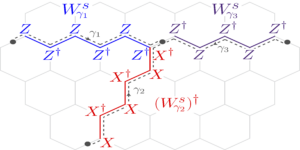1School of Physics and Astronomy, University of Leeds, Leeds LS2 9JT, UK
2Hefei National Laboratory for Physical Sciences at Microscale and Department of Modern Physics, University of Science and Technology of China, Hefei, Anhui 230026, China
3Physikalisches Institut, Ruprecht-Karls-Universität Heidelberg, Im Neuenheimer Feld 226, 69120 Heidelberg, Germany
4CAS Center for Excellence and Synergetic Innovation Center in Quantum Information and Quantum Physics, University of Science and Technology of China, Hefei, Anhui 230026, China
5School of Mathematics and Physics, The University of Queensland, St. Lucia, QLD 4072, Australia
6Department of Physics, Southern University of Science and Technology, Shenzhen 518055, China
7Department of Physics and Arnold Sommerfeld Center for Theoretical Physics (ASC), Ludwig-Maximilians-Universität München, Theresienstraße 37, D-80333 München, Germany
8Munich Center for Quantum Science and Technology (MCQST), Schellingstraße 4, D-80799 München, Germany
Find this paper interesting or want to discuss? Scite or leave a comment on SciRate.
Abstract
The quantum simulation of gauge theories on synthetic quantum matter devices has gained a lot of traction in the last decade, making possible the observation of a range of exotic quantum many-body phenomena. In this work, we consider the spin-$1/2$ quantum link formulation of $1+1$D quantum electrodynamics with a topological $theta$-angle, which can be used to tune a confinement-deconfinement transition. Exactly mapping this system onto a PXP model with mass and staggered magnetization terms, we show an intriguing interplay between confinement and the ergodicity-breaking paradigms of quantum many-body scarring and Hilbert-space fragmentation. We map out the rich dynamical phase diagram of this model, finding an ergodic phase at small values of the mass $mu$ and confining potential $chi$, an emergent integrable phase for large $mu$, and a fragmented phase for large values of both parameters. We also show that the latter hosts resonances that lead to a vast array of effective models. We propose experimental probes of our findings, which can be directly accessed in current cold-atom setups.
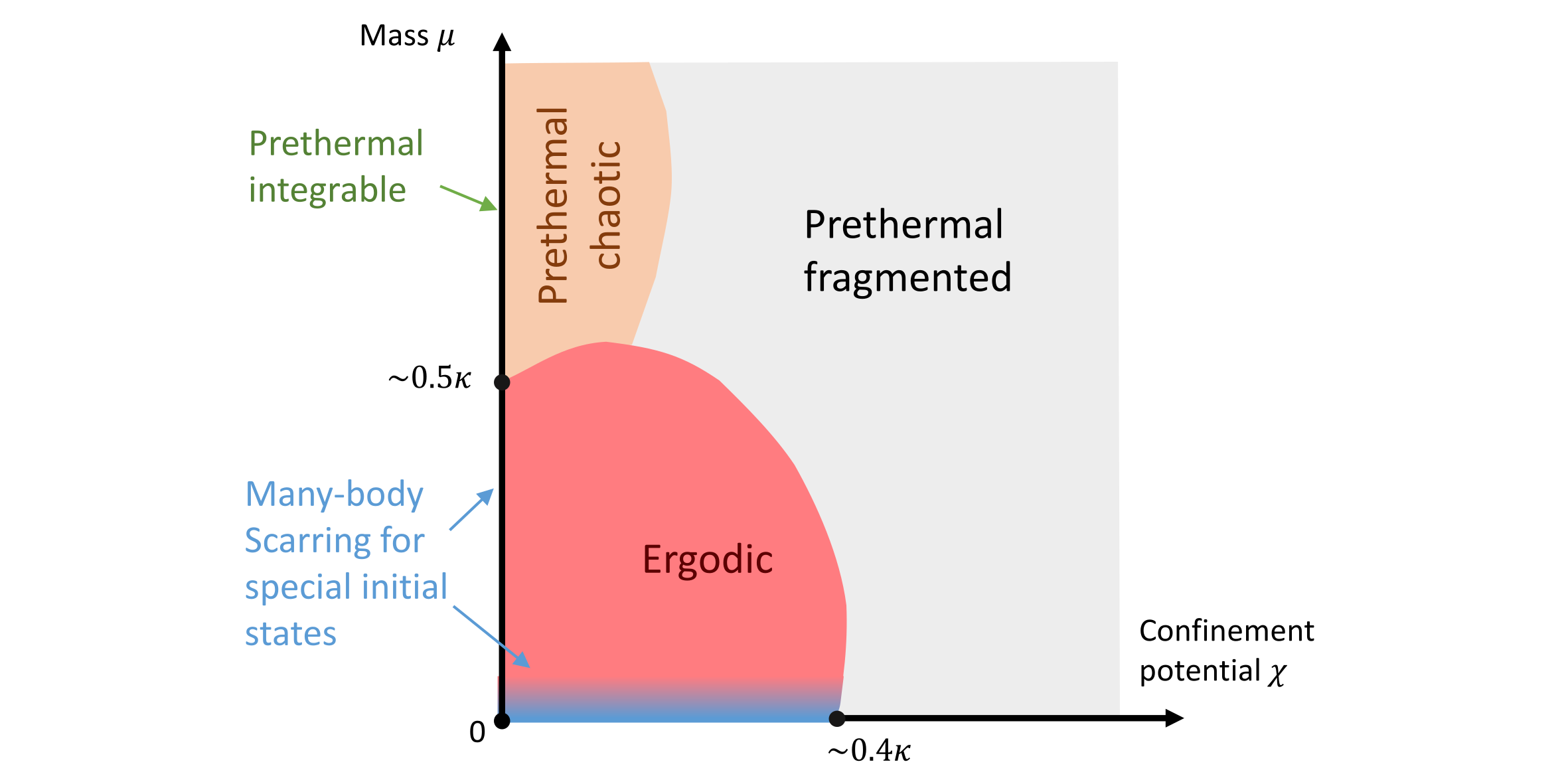
Featured image: Schematic representation of the rich dynamical phase diagram of the spin-1/2 quantum link model.
Popular summary
In our work, we numerically study a spin-1/2 regularization of the Schwinger model which describes 1+1D quantum electrodynamics. We show that varying the model parameters – the fermionic mass and the topological angle – allows one to access a wide range of dynamical phenomena. In particular, we find regimes where quantum dynamics results in persistent oscillations from special initial states, which are identified with quantum many-body scarring. Surprisingly, we find that the scarred oscillations can be enhanced in the presence of confinement. In other parts of parameter space, the Hilbert space fractures into exponentially many components, with an additional structure appearing in the form of two-parameter resonances. Finally, through large-scale numerical simulations, we show that our findings can be realized in the existing experiments on ultracold bosons in optical lattices
► BibTeX data
► References
[1] S. Weinberg. “The quantum theory of fields”. Vol. 2: Modern Applications. Cambridge University Press. (1995).
https://doi.org/10.1017/CBO9781139644174
[2] C. Gattringer and C. Lang. “Quantum chromodynamics on the lattice: An introductory presentation”. Lecture Notes in Physics. Springer Berlin Heidelberg. (2009).
https://doi.org/10.1007/978-3-642-01850-3
[3] A. Zee. “Quantum field theory in a nutshell”. Princeton University Press. (2003). url: https://press.princeton.edu/books/hardcover/9780691140346/quantum-field-theory-in-a-nutshell.
https://press.princeton.edu/books/hardcover/9780691140346/quantum-field-theory-in-a-nutshell
[4] Esteban A. Martinez, Christine A. Muschik, Philipp Schindler, Daniel Nigg, Alexander Erhard, Markus Heyl, Philipp Hauke, Marcello Dalmonte, Thomas Monz, Peter Zoller, and Rainer Blatt. “Real-time dynamics of lattice gauge theories with a few-qubit quantum computer”. Nature 534, 516–519 (2016).
https://doi.org/10.1038/nature18318
[5] Christine Muschik, Markus Heyl, Esteban Martinez, Thomas Monz, Philipp Schindler, Berit Vogell, Marcello Dalmonte, Philipp Hauke, Rainer Blatt, and Peter Zoller. “U(1) Wilson lattice gauge theories in digital quantum simulators”. New Journal of Physics 19, 103020 (2017).
https://doi.org/10.1088/1367-2630/aa89ab
[6] Hannes Bernien, Sylvain Schwartz, Alexander Keesling, Harry Levine, Ahmed Omran, Hannes Pichler, Soonwon Choi, Alexander S. Zibrov, Manuel Endres, Markus Greiner, Vladan Vuletić, and Mikhail D. Lukin. “Probing many-body dynamics on a 51-atom quantum simulator”. Nature 551, 579–584 (2017).
https://doi.org/10.1038/nature24622
[7] N. Klco, E. F. Dumitrescu, A. J. McCaskey, T. D. Morris, R. C. Pooser, M. Sanz, E. Solano, P. Lougovski, and M. J. Savage. “Quantum-classical computation of Schwinger model dynamics using quantum computers”. Phys. Rev. A 98, 032331 (2018).
https://doi.org/10.1103/PhysRevA.98.032331
[8] C. Kokail, C. Maier, R. van Bijnen, T. Brydges, M. K. Joshi, P. Jurcevic, C. A. Muschik, P. Silvi, R. Blatt, C. F. Roos, and P. Zoller. “Self-verifying variational quantum simulation of lattice models”. Nature 569, 355–360 (2019).
https://doi.org/10.1038/s41586-019-1177-4
[9] Christian Schweizer, Fabian Grusdt, Moritz Berngruber, Luca Barbiero, Eugene Demler, Nathan Goldman, Immanuel Bloch, and Monika Aidelsburger. “Floquet approach to $mathbb{Z}_2$ lattice gauge theories with ultracold atoms in optical lattices”. Nature Physics 15, 1168–1173 (2019).
https://doi.org/10.1038/s41567-019-0649-7
[10] Frederik Görg, Kilian Sandholzer, Joaquín Minguzzi, Rémi Desbuquois, Michael Messer, and Tilman Esslinger. “Realization of density-dependent Peierls phases to engineer quantized gauge fields coupled to ultracold matter”. Nature Physics 15, 1161–1167 (2019).
https://doi.org/10.1038/s41567-019-0615-4
[11] Alexander Mil, Torsten V. Zache, Apoorva Hegde, Andy Xia, Rohit P. Bhatt, Markus K. Oberthaler, Philipp Hauke, Jürgen Berges, and Fred Jendrzejewski. “A scalable realization of local U(1) gauge invariance in cold atomic mixtures”. Science 367, 1128–1130 (2020).
https://doi.org/10.1126/science.aaz5312
[12] Natalie Klco, Martin J. Savage, and Jesse R. Stryker. “SU(2) non-abelian gauge field theory in one dimension on digital quantum computers”. Phys. Rev. D 101, 074512 (2020).
https://doi.org/10.1103/PhysRevD.101.074512
[13] Bing Yang, Hui Sun, Robert Ott, Han-Yi Wang, Torsten V. Zache, Jad C. Halimeh, Zhen-Sheng Yuan, Philipp Hauke, and Jian-Wei Pan. “Observation of gauge invariance in a 71-site Bose–Hubbard quantum simulator”. Nature 587, 392–396 (2020).
https://doi.org/10.1038/s41586-020-2910-8
[14] Zhao-Yu Zhou, Guo-Xian Su, Jad C. Halimeh, Robert Ott, Hui Sun, Philipp Hauke, Bing Yang, Zhen-Sheng Yuan, Jürgen Berges, and Jian-Wei Pan. “Thermalization dynamics of a gauge theory on a quantum simulator”. Science 377, 311–314 (2022).
https://doi.org/10.1126/science.abl6277
[15] Nhung H. Nguyen, Minh C. Tran, Yingyue Zhu, Alaina M. Green, C. Huerta Alderete, Zohreh Davoudi, and Norbert M. Linke. “Digital quantum simulation of the Schwinger model and symmetry protection with trapped ions”. PRX Quantum 3, 020324 (2022).
https://doi.org/10.1103/PRXQuantum.3.020324
[16] Zhan Wang, Zi-Yong Ge, Zhongcheng Xiang, Xiaohui Song, Rui-Zhen Huang, Pengtao Song, Xue-Yi Guo, Luhong Su, Kai Xu, Dongning Zheng, and Heng Fan. “Observation of emergent $mathbb{Z}_2$ gauge invariance in a superconducting circuit”. Phys. Rev. Research 4, L022060 (2022).
https://doi.org/10.1103/PhysRevResearch.4.L022060
[17] Julius Mildenberger, Wojciech Mruczkiewicz, Jad C. Halimeh, Zhang Jiang, and Philipp Hauke. “Probing confinement in a $mathbb{Z}_2$ lattice gauge theory on a quantum computer” (2022). arXiv:2203.08905.
arXiv:2203.08905
[18] Yuri Alexeev, Dave Bacon, Kenneth R. Brown, Robert Calderbank, Lincoln D. Carr, Frederic T. Chong, Brian DeMarco, Dirk Englund, Edward Farhi, Bill Fefferman, Alexey V. Gorshkov, Andrew Houck, Jungsang Kim, Shelby Kimmel, Michael Lange, Seth Lloyd, Mikhail D. Lukin, Dmitri Maslov, Peter Maunz, Christopher Monroe, John Preskill, Martin Roetteler, Martin J. Savage, and Jeff Thompson. “Quantum computer systems for scientific discovery”. PRX Quantum 2, 017001 (2021).
https://doi.org/10.1103/PRXQuantum.2.017001
[19] Natalie Klco, Alessandro Roggero, and Martin J Savage. “Standard model physics and the digital quantum revolution: thoughts about the interface”. Reports on Progress in Physics 85, 064301 (2022).
https://doi.org/10.1088/1361-6633/ac58a4
[20] M. Dalmonte and S. Montangero. “Lattice gauge theory simulations in the quantum information era”. Contemporary Physics 57, 388–412 (2016).
https://doi.org/10.1080/00107514.2016.1151199
[21] Erez Zohar, J Ignacio Cirac, and Benni Reznik. “Quantum simulations of lattice gauge theories using ultracold atoms in optical lattices”. Reports on Progress in Physics 79, 014401 (2015).
https://doi.org/10.1088/0034-4885/79/1/014401
[22] Monika Aidelsburger, Luca Barbiero, Alejandro Bermudez, Titas Chanda, Alexandre Dauphin, Daniel González-Cuadra, Przemysław R. Grzybowski, Simon Hands, Fred Jendrzejewski, Johannes Jünemann, Gediminas Juzeliūnas, Valentin Kasper, Angelo Piga, Shi-Ju Ran, Matteo Rizzi, Germán Sierra, Luca Tagliacozzo, Emanuele Tirrito, Torsten V. Zache, Jakub Zakrzewski, Erez Zohar, and Maciej Lewenstein. “Cold atoms meet lattice gauge theory”. Philosophical Transactions of the Royal Society A: Mathematical, Physical and Engineering Sciences 380, 20210064 (2022).
https://doi.org/10.1098/rsta.2021.0064
[23] Erez Zohar. “Quantum simulation of lattice gauge theories in more than one space dimension—requirements, challenges and methods”. Philosophical Transactions of the Royal Society of London Series A 380, 20210069 (2022).
https://doi.org/10.1098/rsta.2021.0069
[24] Christian W. Bauer, Zohreh Davoudi, A. Baha Balantekin, Tanmoy Bhattacharya, Marcela Carena, Wibe A. de Jong, Patrick Draper, Aida El-Khadra, Nate Gemelke, Masanori Hanada, Dmitri Kharzeev, Henry Lamm, Ying-Ying Li, Junyu Liu, Mikhail Lukin, Yannick Meurice, Christopher Monroe, Benjamin Nachman, Guido Pagano, John Preskill, Enrico Rinaldi, Alessandro Roggero, David I. Santiago, Martin J. Savage, Irfan Siddiqi, George Siopsis, David Van Zanten, Nathan Wiebe, Yukari Yamauchi, Kübra Yeter-Aydeniz, and Silvia Zorzetti. “Quantum simulation for high-energy physics”. PRX Quantum 4, 027001 (2023).
https://doi.org/10.1103/PRXQuantum.4.027001
[25] Simon Catterall, Roni Harnik, Veronika E. Hubeny, Christian W. Bauer, Asher Berlin, Zohreh Davoudi, Thomas Faulkner, Thomas Hartman, Matthew Headrick, Yonatan F. Kahn, Henry Lamm, Yannick Meurice, Surjeet Rajendran, Mukund Rangamani, and Brian Swingle. “Report of the Snowmass 2021 theory frontier topical group on quantum information science” (2022). arXiv:2209.14839.
arXiv:2209.14839
[26] Jad C. Halimeh, Ian P. McCulloch, Bing Yang, and Philipp Hauke. “Tuning the topological ${theta}$-angle in cold-atom quantum simulators of gauge theories”. PRX Quantum 3, 040316 (2022).
https://doi.org/10.1103/PRXQuantum.3.040316
[27] Yanting Cheng, Shang Liu, Wei Zheng, Pengfei Zhang, and Hui Zhai. “Tunable confinement-deconfinement transition in an ultracold-atom quantum simulator”. PRX Quantum 3, 040317 (2022).
https://doi.org/10.1103/PRXQuantum.3.040317
[28] Boye Buyens, Jutho Haegeman, Henri Verschelde, Frank Verstraete, and Karel Van Acoleyen. “Confinement and string breaking for $mathrm{QED}_2$ in the Hamiltonian picture”. Phys. Rev. X 6, 041040 (2016).
https://doi.org/10.1103/PhysRevX.6.041040
[29] Federica M. Surace, Paolo P. Mazza, Giuliano Giudici, Alessio Lerose, Andrea Gambassi, and Marcello Dalmonte. “Lattice gauge theories and string dynamics in Rydberg atom quantum simulators”. Phys. Rev. X 10, 021041 (2020).
https://doi.org/10.1103/PhysRevX.10.021041
[30] T. M. R. Byrnes, P. Sriganesh, R. J. Bursill, and C. J. Hamer. “Density matrix renormalization group approach to the massive Schwinger model”. Phys. Rev. D 66, 013002 (2002).
https://doi.org/10.1103/PhysRevD.66.013002
[31] Boye Buyens, Jutho Haegeman, Karel Van Acoleyen, Henri Verschelde, and Frank Verstraete. “Matrix product states for gauge field theories”. Phys. Rev. Lett. 113, 091601 (2014).
https://doi.org/10.1103/PhysRevLett.113.091601
[32] Yuya Shimizu and Yoshinobu Kuramashi. “Critical behavior of the lattice schwinger model with a topological term at ${theta}={pi}$ using the Grassmann tensor renormalization group”. Phys. Rev. D 90, 074503 (2014).
https://doi.org/10.1103/PhysRevD.90.074503
[33] Umberto Borla, Ruben Verresen, Fabian Grusdt, and Sergej Moroz. “Confined phases of one-dimensional spinless fermions coupled to ${Z}_{2}$ gauge theory”. Phys. Rev. Lett. 124, 120503 (2020).
https://doi.org/10.1103/PhysRevLett.124.120503
[34] MatjažKebrič, Luca Barbiero, Christian Reinmoser, Ulrich Schollwöck, and Fabian Grusdt. “Confinement and mott transitions of dynamical charges in one-dimensional lattice gauge theories”. Phys. Rev. Lett. 127, 167203 (2021).
https://doi.org/10.1103/PhysRevLett.127.167203
[35] Marton Kormos, Mario Collura, Gabor Takács, and Pasquale Calabrese. “Real-time confinement following a quantum quench to a non-integrable model”. Nature Physics 13, 246–249 (2017).
https://doi.org/10.1038/nphys3934
[36] Fangli Liu, Rex Lundgren, Paraj Titum, Guido Pagano, Jiehang Zhang, Christopher Monroe, and Alexey V. Gorshkov. “Confined quasiparticle dynamics in long-range interacting quantum spin chains”. Phys. Rev. Lett. 122, 150601 (2019).
https://doi.org/10.1103/PhysRevLett.122.150601
[37] Alvise Bastianello, Umberto Borla, and Sergej Moroz. “Fragmentation and emergent integrable transport in the weakly tilted Ising chain”. Phys. Rev. Lett. 128, 196601 (2022).
https://doi.org/10.1103/PhysRevLett.128.196601
[38] Stefan Birnkammer, Alvise Bastianello, and Michael Knap. “Prethermalization in one-dimensional quantum many-body systems with confinement”. Nature Communications 13, 7663 (2022).
https://doi.org/10.1038/s41467-022-35301-6
[39] Sidney Coleman. “More about the massive Schwinger model”. Annals of Physics 101, 239 – 267 (1976).
https://doi.org/10.1016/0003-4916(76)90280-3
[40] A. Smith, J. Knolle, D. L. Kovrizhin, and R. Moessner. “Disorder-free localization”. Phys. Rev. Lett. 118, 266601 (2017).
https://doi.org/10.1103/PhysRevLett.118.266601
[41] Marlon Brenes, Marcello Dalmonte, Markus Heyl, and Antonello Scardicchio. “Many-body localization dynamics from gauge invariance”. Phys. Rev. Lett. 120, 030601 (2018).
https://doi.org/10.1103/PhysRevLett.120.030601
[42] A. Smith, J. Knolle, R. Moessner, and D. L. Kovrizhin. “Absence of ergodicity without quenched disorder: From quantum disentangled liquids to many-body localization”. Phys. Rev. Lett. 119, 176601 (2017).
https://doi.org/10.1103/PhysRevLett.119.176601
[43] Alexandros Metavitsiadis, Angelo Pidatella, and Wolfram Brenig. “Thermal transport in a two-dimensional $mathbb{Z}_2$ spin liquid”. Phys. Rev. B 96, 205121 (2017).
https://doi.org/10.1103/PhysRevB.96.205121
[44] Adam Smith, Johannes Knolle, Roderich Moessner, and Dmitry L. Kovrizhin. “Dynamical localization in $mathbb{Z}_2$ lattice gauge theories”. Phys. Rev. B 97, 245137 (2018).
https://doi.org/10.1103/PhysRevB.97.245137
[45] Angelo Russomanno, Simone Notarnicola, Federica Maria Surace, Rosario Fazio, Marcello Dalmonte, and Markus Heyl. “Homogeneous Floquet time crystal protected by gauge invariance”. Phys. Rev. Research 2, 012003 (2020).
https://doi.org/10.1103/PhysRevResearch.2.012003
[46] Irene Papaefstathiou, Adam Smith, and Johannes Knolle. “Disorder-free localization in a simple $U(1)$ lattice gauge theory”. Phys. Rev. B 102, 165132 (2020).
https://doi.org/10.1103/PhysRevB.102.165132
[47] Paul A. McClarty, Masudul Haque, Arnab Sen, and Johannes Richter. “Disorder-free localization and many-body quantum scars from magnetic frustration”. Phys. Rev. B 102, 224303 (2020).
https://doi.org/10.1103/PhysRevB.102.224303
[48] Oliver Hart, Sarang Gopalakrishnan, and Claudio Castelnovo. “Logarithmic entanglement growth from disorder-free localization in the two-leg compass ladder”. Phys. Rev. Lett. 126, 227202 (2021).
https://doi.org/10.1103/PhysRevLett.126.227202
[49] Guo-Yi Zhu and Markus Heyl. “Subdiffusive dynamics and critical quantum correlations in a disorder-free localized Kitaev honeycomb model out of equilibrium”. Phys. Rev. Research 3, L032069 (2021).
https://doi.org/10.1103/PhysRevResearch.3.L032069
[50] John Sous, Benedikt Kloss, Dante M. Kennes, David R. Reichman, and Andrew J. Millis. “Phonon-induced disorder in dynamics of optically pumped metals from nonlinear electron-phonon coupling”. Nature Communications 12, 5803 (2021).
https://doi.org/10.1038/s41467-021-26030-3
[51] P. Karpov, R. Verdel, Y.-P. Huang, M. Schmitt, and M. Heyl. “Disorder-free localization in an interacting 2D lattice gauge theory”. Phys. Rev. Lett. 126, 130401 (2021).
https://doi.org/10.1103/PhysRevLett.126.130401
[52] Nilotpal Chakraborty, Markus Heyl, Petr Karpov, and Roderich Moessner. “Disorder-free localization transition in a two-dimensional lattice gauge theory”. Phys. Rev. B 106, L060308 (2022).
https://doi.org/10.1103/PhysRevB.106.L060308
[53] Jad C. Halimeh, Philipp Hauke, Johannes Knolle, and Fabian Grusdt. “Temperature-induced disorder-free localization” (2022). arXiv:2206.11273.
arXiv:2206.11273
[54] Sanjay Moudgalya, Stephan Rachel, B. Andrei Bernevig, and Nicolas Regnault. “Exact excited states of nonintegrable models”. Phys. Rev. B 98, 235155 (2018).
https://doi.org/10.1103/PhysRevB.98.235155
[55] C. J. Turner, A. A. Michailidis, D. A. Abanin, M. Serbyn, and Z. Papić. “Weak ergodicity breaking from quantum many-body scars”. Nature Physics 14, 745–749 (2018).
https://doi.org/10.1038/s41567-018-0137-5
[56] Pablo Sala, Tibor Rakovszky, Ruben Verresen, Michael Knap, and Frank Pollmann. “Ergodicity breaking arising from Hilbert space fragmentation in dipole-conserving Hamiltonians”. Phys. Rev. X 10, 011047 (2020).
https://doi.org/10.1103/PhysRevX.10.011047
[57] Vedika Khemani, Michael Hermele, and Rahul Nandkishore. “Localization from hilbert space shattering: From theory to physical realizations”. Phys. Rev. B 101, 174204 (2020).
https://doi.org/10.1103/PhysRevB.101.174204
[58] Luca D’Alessio, Yariv Kafri, Anatoli Polkovnikov, and Marcos Rigol. “From quantum chaos and eigenstate thermalization to statistical mechanics and thermodynamics”. Advances in Physics 65, 239–362 (2016).
https://doi.org/10.1080/00018732.2016.1198134
[59] Joshua M Deutsch. “Eigenstate thermalization hypothesis”. Reports on Progress in Physics 81, 082001 (2018).
https://doi.org/10.1088/1361-6633/aac9f1
[60] Berislav Buča. “Unified theory of local quantum many-body dynamics: Eigenoperator thermalization theorems”. Phys. Rev. X 13, 031013 (2023).
https://doi.org/10.1103/PhysRevX.13.031013
[61] S Chandrasekharan and U.-J Wiese. “Quantum link models: A discrete approach to gauge theories”. Nuclear Physics B 492, 455 – 471 (1997).
https://doi.org/10.1016/S0550-3213(97)80041-7
[62] U.-J. Wiese. “Ultracold quantum gases and lattice systems: quantum simulation of lattice gauge theories”. Annalen der Physik 525, 777–796 (2013).
https://doi.org/10.1002/andp.201300104
[63] V Kasper, F Hebenstreit, F Jendrzejewski, M K Oberthaler, and J Berges. “Implementing quantum electrodynamics with ultracold atomic systems”. New Journal of Physics 19, 023030 (2017).
https://doi.org/10.1088/1367-2630/aa54e0
[64] Guo-Xian Su, Hui Sun, Ana Hudomal, Jean-Yves Desaules, Zhao-Yu Zhou, Bing Yang, Jad C. Halimeh, Zhen-Sheng Yuan, Zlatko Papić, and Jian-Wei Pan. “Observation of many-body scarring in a Bose-Hubbard quantum simulator”. Phys. Rev. Res. 5, 023010 (2023).
https://doi.org/10.1103/PhysRevResearch.5.023010
[65] Ana Hudomal, Jean-Yves Desaules, Bhaskar Mukherjee, Guo-Xian Su, Jad C. Halimeh, and Zlatko Papić. “Driving quantum many-body scars in the PXP model”. Phys. Rev. B 106, 104302 (2022).
https://doi.org/10.1103/PhysRevB.106.104302
[66] Debasish Banerjee and Arnab Sen. “Quantum scars from zero modes in an abelian lattice gauge theory on ladders”. Phys. Rev. Lett. 126, 220601 (2021).
https://doi.org/10.1103/PhysRevLett.126.220601
[67] Jean-Yves Desaules, Debasish Banerjee, Ana Hudomal, Zlatko Papić, Arnab Sen, and Jad C. Halimeh. “Weak ergodicity breaking in the Schwinger model”. Phys. Rev. B 107, L201105 (2023).
https://doi.org/10.1103/PhysRevB.107.L201105
[68] Jean-Yves Desaules, Ana Hudomal, Debasish Banerjee, Arnab Sen, Zlatko Papić, and Jad C. Halimeh. “Prominent quantum many-body scars in a truncated Schwinger model”. Phys. Rev. B 107, 205112 (2023).
https://doi.org/10.1103/PhysRevB.107.205112
[69] Sanjay Moudgalya and Olexei I. Motrunich. “Hilbert space fragmentation and commutant algebras”. Phys. Rev. X 12, 011050 (2022).
https://doi.org/10.1103/PhysRevX.12.011050
[70] Tibor Rakovszky, Pablo Sala, Ruben Verresen, Michael Knap, and Frank Pollmann. “Statistical localization: From strong fragmentation to strong edge modes”. Phys. Rev. B 101, 125126 (2020).
https://doi.org/10.1103/PhysRevB.101.125126
[71] Giuseppe De Tomasi, Daniel Hetterich, Pablo Sala, and Frank Pollmann. “Dynamics of strongly interacting systems: From Fock-space fragmentation to many-body localization”. Phys. Rev. B 100, 214313 (2019).
https://doi.org/10.1103/PhysRevB.100.214313
[72] Zhi-Cheng Yang, Fangli Liu, Alexey V. Gorshkov, and Thomas Iadecola. “Hilbert-space fragmentation from strict confinement”. Phys. Rev. Lett. 124, 207602 (2020).
https://doi.org/10.1103/PhysRevLett.124.207602
[73] I-Chi Chen and Thomas Iadecola. “Emergent symmetries and slow quantum dynamics in a Rydberg-atom chain with confinement”. Phys. Rev. B 103, 214304 (2021).
https://doi.org/10.1103/PhysRevB.103.214304
[74] Sebastian Scherg, Thomas Kohlert, Pablo Sala, Frank Pollmann, Bharath Hebbe Madhusudhana, Immanuel Bloch, and Monika Aidelsburger. “Observing non-ergodicity due to kinetic constraints in tilted Fermi-Hubbard chains”. Nature Communications 12, 4490 (2021).
https://doi.org/10.1038/s41467-021-24726-0
[75] Thomas Kohlert, Sebastian Scherg, Pablo Sala, Frank Pollmann, Bharath Hebbe Madhusudhana, Immanuel Bloch, and Monika Aidelsburger. “Exploring the regime of fragmentation in strongly tilted Fermi-Hubbard chains”. Phys. Rev. Lett. 130, 010201 (2023).
https://doi.org/10.1103/PhysRevLett.130.010201
[76] Andrew J. A. James, Robert M. Konik, and Neil J. Robinson. “Nonthermal states arising from confinement in one and two dimensions”. Phys. Rev. Lett. 122, 130603 (2019).
https://doi.org/10.1103/PhysRevLett.122.130603
[77] Neil J. Robinson, Andrew J. A. James, and Robert M. Konik. “Signatures of rare states and thermalization in a theory with confinement”. Phys. Rev. B 99, 195108 (2019).
https://doi.org/10.1103/PhysRevB.99.195108
[78] Paolo Pietro Mazza, Gabriele Perfetto, Alessio Lerose, Mario Collura, and Andrea Gambassi. “Suppression of transport in nondisordered quantum spin chains due to confined excitations”. Phys. Rev. B 99, 180302(R) (2019).
https://doi.org/10.1103/PhysRevB.99.180302
[79] Alessio Lerose, Federica M. Surace, Paolo P. Mazza, Gabriele Perfetto, Mario Collura, and Andrea Gambassi. “Quasilocalized dynamics from confinement of quantum excitations”. Phys. Rev. B 102, 041118 (2020).
https://doi.org/10.1103/PhysRevB.102.041118
[80] Ulrich Schollwöck. “The density-matrix renormalization group in the age of matrix product states”. Annals of Physics 326, 96–192 (2011).
https://doi.org/10.1016/j.aop.2010.09.012
[81] Sebastian Paeckel, Thomas Köhler, Andreas Swoboda, Salvatore R. Manmana, Ulrich Schollwöck, and Claudius Hubig. “Time-evolution methods for matrix-product states”. Annals of Physics 411, 167998 (2019).
https://doi.org/10.1016/j.aop.2019.167998
[82] See the Supplemental Material for additional analysis and background calculations to support the results in the main text. The supplementary material contains Refs. [73, 92, 93, 93-35, 98, 102-104].
[83] Dayou Yang, Gouri Shankar Giri, Michael Johanning, Christof Wunderlich, Peter Zoller, and Philipp Hauke. “Analog quantum simulation of $(1+1)$-dimensional lattice QED with trapped ions”. Phys. Rev. A 94, 052321 (2016).
https://doi.org/10.1103/PhysRevA.94.052321
[84] E. Rico, T. Pichler, M. Dalmonte, P. Zoller, and S. Montangero. “Tensor networks for lattice gauge theories and atomic quantum simulation”. Phys. Rev. Lett. 112, 201601 (2014).
https://doi.org/10.1103/PhysRevLett.112.201601
[85] Maarten Van Damme, Jad C. Halimeh, and Philipp Hauke. “Gauge-symmetry violation quantum phase transition in lattice gauge theories” (2020). arXiv:2010.07338.
arXiv:2010.07338
[86] Sidney Coleman, R Jackiw, and Leonard Susskind. “Charge shielding and quark confinement in the massive Schwinger model”. Annals of Physics 93, 267–275 (1975).
https://doi.org/10.1016/0003-4916(75)90212-2
[87] Soonwon Choi, Christopher J. Turner, Hannes Pichler, Wen Wei Ho, Alexios A. Michailidis, Zlatko Papić, Maksym Serbyn, Mikhail D. Lukin, and Dmitry A. Abanin. “Emergent SU(2) dynamics and perfect quantum many-body scars”. Phys. Rev. Lett. 122, 220603 (2019).
https://doi.org/10.1103/PhysRevLett.122.220603
[88] Berislav Buča, Joseph Tindall, and Dieter Jaksch. “Non-stationary coherent quantum many-body dynamics through dissipation”. Nature Communications 10, 1730 (2019).
https://doi.org/10.1038/s41467-019-09757-y
[89] Thomas Iadecola, Michael Schecter, and Shenglong Xu. “Quantum many-body scars from magnon condensation”. Phys. Rev. B 100, 184312 (2019).
https://doi.org/10.1103/PhysRevB.100.184312
[90] Kieran Bull, Jean-Yves Desaules, and Zlatko Papić. “Quantum scars as embeddings of weakly broken Lie algebra representations”. Phys. Rev. B 101, 165139 (2020).
https://doi.org/10.1103/PhysRevB.101.165139
[91] Budhaditya Bhattacharjee, Samudra Sur, and Pratik Nandy. “Probing quantum scars and weak ergodicity breaking through quantum complexity”. Phys. Rev. B 106, 205150 (2022).
https://doi.org/10.1103/PhysRevB.106.205150
[92] Keita Omiya and Markus Müller. “Quantum many-body scars in bipartite Rydberg arrays originating from hidden projector embedding”. Phys. Rev. A 107, 023318 (2023).
https://doi.org/10.1103/PhysRevA.107.023318
[93] Wen Wei Ho, Soonwon Choi, Hannes Pichler, and Mikhail D. Lukin. “Periodic orbits, entanglement, and quantum many-body scars in constrained models: Matrix product state approach”. Phys. Rev. Lett. 122, 040603 (2019).
https://doi.org/10.1103/PhysRevLett.122.040603
[94] Paul Fendley, K. Sengupta, and Subir Sachdev. “Competing density-wave orders in a one-dimensional hard-boson model”. Phys. Rev. B 69, 075106 (2004).
https://doi.org/10.1103/PhysRevB.69.075106
[95] Paul Fendley, Bernard Nienhuis, and Kareljan Schoutens. “Lattice fermion models with supersymmetry”. Journal of Physics A: Mathematical and General 36, 12399 (2003).
https://doi.org/10.1088/0305-4470/36/50/004
[96] Haifeng Lang, Philipp Hauke, Johannes Knolle, Fabian Grusdt, and Jad C. Halimeh. “Disorder-free localization with Stark gauge protection”. Phys. Rev. B 106, 174305 (2022).
https://doi.org/10.1103/PhysRevB.106.174305
[97] Jad C. Halimeh, Haifeng Lang, Julius Mildenberger, Zhang Jiang, and Philipp Hauke. “Gauge-symmetry protection using single-body terms”. PRX Quantum 2, 040311 (2021).
https://doi.org/10.1103/PRXQuantum.2.040311
[98] Johannes Hauschild and Frank Pollmann. “Efficient numerical simulations with Tensor Networks: Tensor Network Python (TeNPy)”. SciPost Phys. Lect. NotesPage 5 (2018).
https://doi.org/10.21468/SciPostPhysLectNotes.5
[99] Wei-Yong Zhang, Ying Liu, Yanting Cheng, Ming-Gen He, Han-Yi Wang, Tian-Yi Wang, Zi-Hang Zhu, Guo-Xian Su, Zhao-Yu Zhou, Yong-Guang Zheng, Hui Sun, Bing Yang, Philipp Hauke, Wei Zheng, Jad C. Halimeh, Zhen-Sheng Yuan, and Jian-Wei Pan. “Observation of microscopic confinement dynamics by a tunable topological $theta$-angle” (2023). arXiv:2306.11794.
arXiv:2306.11794
[100] Adith Sai Aramthottil, Utso Bhattacharya, Daniel González-Cuadra, Maciej Lewenstein, Luca Barbiero, and Jakub Zakrzewski. “Scar states in deconfined $mathbb{Z}_2$ lattice gauge theories”. Phys. Rev. B 106, L041101 (2022).
https://doi.org/10.1103/PhysRevB.106.L041101
[101] Vadim Oganesyan and David A. Huse. “Localization of interacting fermions at high temperature”. Phys. Rev. B 75, 155111 (2007).
https://doi.org/10.1103/PhysRevB.75.155111
[102] Sergey Bravyi, David P. DiVincenzo, and Daniel Loss. “Schrieffer–wolff transformation for quantum many-body systems”. Annals of Physics 326, 2793 – 2826 (2011).
https://doi.org/10.1016/j.aop.2011.06.004
[103] A. A. Michailidis, C. J. Turner, Z. Papić, D. A. Abanin, and M. Serbyn. “Slow quantum thermalization and many-body revivals from mixed phase space”. Phys. Rev. X 10, 011055 (2020).
https://doi.org/10.1103/PhysRevX.10.011055
[104] C. J. Turner, J.-Y. Desaules, K. Bull, and Z. Papić. “Correspondence principle for many-body scars in ultracold Rydberg atoms”. Phys. Rev. X 11, 021021 (2021).
https://doi.org/10.1103/PhysRevX.11.021021
Cited by
[1] Roland C. Farrell, Marc Illa, Anthony N. Ciavarella, and Martin J. Savage, “Quantum Simulations of Hadron Dynamics in the Schwinger Model using 112 Qubits”, arXiv:2401.08044, (2024).
[2] Pranay Patil, Ayushi Singhania, and Jad C. Halimeh, “Protecting Hilbert space fragmentation through quantum Zeno dynamics”, Physical Review B 108 19, 195109 (2023).
The above citations are from SAO/NASA ADS (last updated successfully 2024-02-29 16:07:55). The list may be incomplete as not all publishers provide suitable and complete citation data.
Could not fetch Crossref cited-by data during last attempt 2024-02-29 16:07:54: Could not fetch cited-by data for 10.22331/q-2024-02-29-1274 from Crossref. This is normal if the DOI was registered recently.
This Paper is published in Quantum under the Creative Commons Attribution 4.0 International (CC BY 4.0) license. Copyright remains with the original copyright holders such as the authors or their institutions.
- SEO Powered Content & PR Distribution. Get Amplified Today.
- PlatoData.Network Vertical Generative Ai. Empower Yourself. Access Here.
- PlatoAiStream. Web3 Intelligence. Knowledge Amplified. Access Here.
- PlatoESG. Carbon, CleanTech, Energy, Environment, Solar, Waste Management. Access Here.
- PlatoHealth. Biotech and Clinical Trials Intelligence. Access Here.
- Source: https://quantum-journal.org/papers/q-2024-02-29-1274/
- :has
- :is
- :not
- :where
- ][p
- 06
- 07
- 09
- 1
- 10
- 100
- 11
- 118
- 12
- 120
- 13
- 130
- 14
- 15%
- 16
- 17
- 19
- 1995
- 20
- 2009
- 2011
- 2013
- 2014
- 2015
- 2016
- 2017
- 2018
- 2019
- 2020
- 2021
- 2022
- 2023
- 2024
- 22
- 23
- 24
- 25
- 26%
- 27
- 28
- 29
- 2D
- 30
- 31
- 32
- 33
- 35%
- 36
- 39
- 40
- 41
- 43
- 455
- 49
- 50
- 51
- 54
- 58
- 60
- 65
- 66
- 67
- 7
- 70
- 72
- 75
- 77
- 8
- 80
- 84
- 87
- 89
- 9
- 91
- 97
- 98
- a
- About
- above
- ABSTRACT
- access
- accessed
- across
- Adam
- Additional
- advances
- affiliations
- age
- ahmed
- Alexander
- All
- allows
- also
- alternative
- an
- Ana
- analog
- analysis
- and
- Andrew
- angle
- Anthony
- appearing
- applications
- approach
- ARE
- arising
- Array
- AS
- asher
- astronomy
- At
- atom
- atomic
- attempt
- author
- authors
- background
- BE
- behavior
- Benjamin
- Berlin
- between
- Bill
- Bing
- both
- Break
- Breaking
- Brian
- Broken
- brown
- bull
- by
- calculations
- cambridge
- CAN
- Center
- chain
- chains
- challenges
- Chaos
- charges
- chen
- Cheng
- China
- chong
- christian
- Christine
- Christopher
- COHERENT
- cold
- comment
- Commons
- Communications
- Compass
- complete
- complexity
- components
- computation
- computer
- computers
- Condensed matter
- Consider
- constraints
- contains
- contemporary
- copyright
- correlations
- could
- coupled
- critical
- Crystal
- Current
- Daniel
- data
- Dave
- David
- de
- decade
- Department
- describes
- description
- Devices
- diagram
- digital
- Dimension
- dimensions
- directly
- discovery
- discuss
- disorder
- draper
- due
- during
- dynamics
- e
- Early
- Early Universe
- Edge
- Edward
- Effective
- embedding
- emerged
- engineer
- Engineering
- enhanced
- entanglement
- Equilibrium
- Era
- erez
- eugene
- Even
- evolution
- exactly
- Excellence
- excited
- existing
- Exotic
- experimental
- experiments
- exponentially
- fan
- Feb
- field
- Fields
- Finally
- Find
- finding
- findings
- following
- For
- form
- fragmentation
- fragmented
- frank
- from
- Frontier
- frustration
- FSS
- fundamental
- gained
- gauge
- ge
- General
- George
- goldman
- Green
- Group
- Growth
- Hands
- harvard
- he
- henry
- Hidden
- High
- holders
- hosts
- HTTPS
- huang
- i
- identified
- if
- image
- in
- In other
- information
- initial
- Innovation
- institutions
- interacting
- interesting
- Interface
- International
- into
- intriguing
- introductory
- james
- JavaScript
- Jian-Wei Pan
- John
- Joshi
- joshua
- journal
- Julius
- kenneth
- Kim
- laboratory
- ladder
- LANG
- large
- large-scale
- Last
- lead
- Leave
- Lecture
- leonard
- levine
- Li
- License
- lie
- light
- Lincoln
- LINK
- Liquid
- List
- local
- Localization
- London
- loss
- Lot
- Maier
- Main
- Making
- many
- map
- mapping
- maria
- mario
- Martin
- Mass
- massive
- material
- mathematical
- mathematics
- Matrix
- Matter
- matthew
- max-width
- May..
- mechanics
- Meet
- messer
- Metals
- methods
- Michael
- microscopic
- mikhail
- mixed
- model
- models
- Modern
- modes
- Month
- more
- Mukherjee
- National
- Nature
- network
- networks
- New
- Nguyen
- Nicolas
- nonlinear
- normal
- Notes
- nuclear
- Nuclear physics
- Nutshell
- observation
- of
- oliver
- on
- ONE
- onto
- open
- or
- orders
- original
- originating
- Other
- our
- out
- pablo
- pages
- Paolo
- Paper
- paradigms
- Parallel
- parameter
- parameters
- particular
- parts
- patrick
- Paul
- perfect
- Peter
- phase
- phases
- physical
- Physical Sciences
- Physics
- picture
- Pietro
- plato
- Plato Data Intelligence
- PlatoData
- possible
- potential
- powerful
- presence
- presentation
- press
- Princeton
- principle
- Product
- Progress
- promises
- properties
- propose
- protected
- protecting
- protection
- provide
- published
- publisher
- publishers
- Python
- Quantum
- Quantum Computer
- quantum computers
- quantum information
- quantum physics
- quantum revolution
- qubits
- R
- range
- RARE
- realization
- realized
- recently
- references
- regime
- regimes
- registered
- remains
- Reports
- representation
- research
- Results
- review
- Revolution
- Rich
- Richter
- RICO
- ROBERT
- Roland
- royal
- s
- scalable
- Science
- Science and Technology
- SCIENCES
- scientific
- see
- Series
- Series A
- shed
- shenzhen
- show
- silvia
- Simon
- Simple
- simulation
- simulations
- simulator
- slow
- small
- smith
- Society
- song
- Southern
- Space
- special
- Spin
- stark
- State
- States
- statistical
- stefan
- Strict
- String
- strong
- strongly
- structure
- Study
- Successfully
- such
- suitable
- Sun
- superconducting
- support
- surprisingly
- synthetic
- system
- Systems
- Technology
- term
- terms
- text
- than
- that
- The
- their
- theoretical
- theory
- this
- thomas
- thompson
- Through
- time
- Title
- to
- traction
- traditional
- Transactions
- Transformation
- transition
- transitions
- transport
- trapped
- tune
- two
- Ultracold matter
- under
- understanding
- Universe
- university
- University of Science and Technology of China
- updated
- URL
- used
- using
- Values
- variety
- varying
- Vast
- VIOLATION
- volume
- W
- wang
- want
- was
- we
- weak
- which
- wide
- Wide range
- Wilson
- with
- without
- Work
- X
- yannick
- year
- YING
- Yuan
- zee
- zephyrnet
- zero





